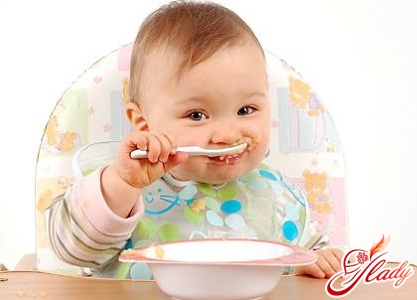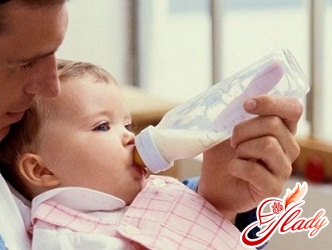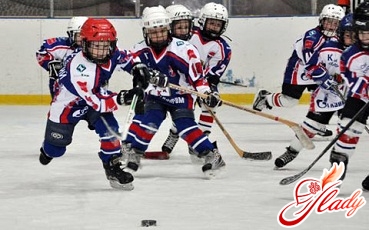 Mother's milk is, without a doubt, the mosta useful and valuable food product for children in their first year of life. However, unfortunately, for a number of reasons, sometimes it is not possible to breastfeed a baby at all, or for a very short time. It is in this case that infant formulas come to the aid of young parents. Infant formulas for newborns cause a variety of reviews. Some people like formulas from domestic manufacturers, while others prefer imported analogues. In rarer cases, some parents still prefer to feed infants with cow's milk. However, as modern pediatricians and nutritionists claim, cow's milk is strictly contraindicated for infants. This statement is explained by the fact that cow's milk absolutely does not meet the physiological needs of an infant. The protein in cow's milk is extremely poorly absorbed and processed by the child's digestive system, often causing the following negative consequences for the baby:
Mother's milk is, without a doubt, the mosta useful and valuable food product for children in their first year of life. However, unfortunately, for a number of reasons, sometimes it is not possible to breastfeed a baby at all, or for a very short time. It is in this case that infant formulas come to the aid of young parents. Infant formulas for newborns cause a variety of reviews. Some people like formulas from domestic manufacturers, while others prefer imported analogues. In rarer cases, some parents still prefer to feed infants with cow's milk. However, as modern pediatricians and nutritionists claim, cow's milk is strictly contraindicated for infants. This statement is explained by the fact that cow's milk absolutely does not meet the physiological needs of an infant. The protein in cow's milk is extremely poorly absorbed and processed by the child's digestive system, often causing the following negative consequences for the baby:
- Disturbance of digestion - the baby can periodically occur that constipation, and then diarrhea.
- Also, very often it is cow's milk that provokes the development of a baby such an unpleasant and difficult to treat disease, like a dysbacteriosis of the intestine.
- As a consequence of the above two reasons, the crumbs may have the strongest intestinal colic, which delivers many unpleasant minutes to both mom and baby.
In addition, cow's milk contains too mucha large amount of calcium and other minerals, which also has an extremely negative effect on the vital systems of the baby's body. And if in the past this type of feeding was the only way to save a baby from starvation, now there is a huge number of a wide variety of ready-made milk formulas for babies. There are a variety of formulas, and for almost any baby you can choose the formula that is most suitable for him. If we talk about the classification of baby formulas, they are divided according to several criteria:
- Artificial milk formula for baby food of the last generation.
- Artificial milk formula for baby food of modern generation.
- Artificial milk formula intended for feeding children who have no health problems.
- Artificial milk mixtures intended for feeding children with various health problems.
- Dry milk mash, intended for the artificial feeding of infants.
- Liquid ready-made mixtures intended for the artificial feeding of infants.
And if about milk formulas of the previous generationthere is not much to tell, but there is a lot to tell about modern-generation infant formulas. It is about them that we will talk below. Despite the fact that the largest number of artificial infant formulas are produced on the basis of cow's milk, they do not have the same negative impact on the child's body as cow's milk in its pure form. During industrial processing of cow's milk for the production of infant formulas, the amount of minerals and other substances that have a negative impact on the child's health is reduced. And the content of useful substances, such as vitamins, microelements and carbohydrates, on the contrary, increases. Also, many infant formulas are additionally enriched with various vitamins or microelements. For example, if the baby has iron deficiency anemia, the mother should give preference to infant formula with a high iron content, but if there is a lack of calcium, then a formula with a high content of this microelement. Be sure to read the information on the label and remember that you must first consult with a doctor - a pediatrician who is monitoring your baby and who knows the developmental and health characteristics of your baby.
Kinds of children's mixtures
To the mixtures of the previous generation, about whichIt was said a little above, refers to the baby formula Malutka and Malysh. These mixtures themselves are not bad, tested by more than one generation of children, however, if the family's financial capabilities allow, when choosing between the mixtures of the past generation and modern ones, it is still worth giving preference to modern mixtures. Many manufacturers of baby formulas produce various brands of baby food. For example, the company "nestle" produces the baby formula Nan, which belongs to the "premium" class, but also the baby formula Nestogen, which is much cheaper, while practically in no way inferior in its quality. In any case, even the cheapest milk formula is much better than cow's milk.
How to choose a milk formula?
 When deciding on the choice of infant formula, parents simply need to take into account several very important factors on which the health of their baby largely depends:
When deciding on the choice of infant formula, parents simply need to take into account several very important factors on which the health of their baby largely depends:
All these mixtures have approximately the same vitamin content.mineral and fatty acid compositions, as well as the level of protein content. However, the protein itself, as well as fats and oils, can vary significantly. But it is impossible to say for sure which one is better and which is worse. After all, what is ideal for one baby may not suit another. And the price is often not an indicator of which baby formula is better. As a rule, when finding out the question "milk formula - which is better?" in most cases, parents have to act by trial and error. That is why while you are just choosing the right milk formula for your baby, you should not buy a large quantity at once. It is much wiser to buy one package of the formula and observe whether it is suitable for your baby. There are certain signs by which you can determine that this formula is not suitable for your child:
- Any skin allergic skin rash, which was not before introducing a new type of mixture into the diet.
- If a child has a normal stool, there are constipation or, on the contrary, diarrhea.
- If the crumb began to worry and cry because of increased gas formation and, as a consequence, intestinal colic.
If one or more symptoms appear, pediatricians will usually recommend that parents change the infant formula.
Lactose-free mixture
In some cases, it happens that the mother has enough milk, but the child is intolerant to it. This usually happens in two cases:
- Allergy to breast milk. About 5% of cases occur.
- Severe form of lactose insufficiency in the baby.
If you are facing a similar problemyour baby, remember that not only breast milk, but also regular infant formula is strictly contraindicated for him. If your baby suffers from lactose deficiency, either low-lactose formulas or, even better, lactose-free infant formulas are needed for his nutrition. Trying to feed your baby with regular formulas can lead to serious health problems for your baby. Lactose-free infant formulas are irreplaceable for such children. If the baby suffers from allergies, parents need to work with a pediatrician to select a formula for the baby that will not cause allergic reactions. Moreover, this formula may not be the most expensive formula of the latest generation, but a regular cheap formula like "Malutka". Very often in such cases, dry infant formulas based on soy, not milk, come to the aid of parents. Soy in its pure form is a product that is quite useful for the human body, thanks to the protein it contains. Soy protein is very similar in composition to meat protein, but it does not contain cholesterol. Of course, soy also has some disadvantages - for example, a substance that significantly complicates the breakdown of protein. However, soy-based infant formulas do not have this unpleasant feature, since they are diluted with hot water, which destroys the substance that prevents protein breakdown. In addition, soy contains certain sugars that ferment in the baby's large intestine, thereby causing such unpleasant phenomena as bloating of the baby's tummy (flatulence) and, as a result, intestinal colic and tummy pain. In order to prepare lactose-free infant formulas based on soy protein, the industry uses the most purified soy protein - soy isolate. It serves to replace the protein of human or cow's milk. Such mixtures do not contain lactose at all, which means they are ideal for children with lactose intolerance. Recently, a movement aimed at combating the use of genetically modified products, including soy, has become a very big trend. It is this fact that often confuses parents when choosing a formula for a child who has lactose intolerance or an allergy to cow's milk protein. However, such concerns of parents are absolutely groundless, since they have no basis. After all, all products without exception, made from soy, undergo very strict quality control. And baby formulas, in addition, are subject to mandatory registration and certification in the Ministry of Health. All types of formula undergo very thorough studies, such as:
- Study of the structure of soybean DNA.
- Study of allergenic properties of soy.
- A careful study of soybean DNA for mutagenic properties.
And only after all these careful studiesThe Ministry of Health gives permission for this formula to go on sale. And this means only one thing - when buying soy formula for your baby in a store or pharmacy, you can be completely calm and confident that the formula will bring nothing but benefit to the baby. However, remember that soy formulas are far from the only alternative food for a baby who suffers from lactose deficiency or an allergy to cow's milk. A very good substitute for breast milk can be baby formulas made from goat's milk. In Russia, the Nanny baby formula, produced in New Zealand, has become very widespread. Nanny is a hypoallergenic baby formula made from goat's milk. The best baby formula, designed to feed both absolutely healthy children and those prone to atopic dermatitis. This milk formula has no analogues and is ideal for children suffering from individual intolerance to cow's milk protein. There are various Nanny milk formulas for newborns - both regular and enriched with prebiotics. Before making your choice, be sure to consult with your pediatrician.
Therapeutic mixtures
 As mentioned above, there are dairy productsmixtures from birth, which not only satisfy the child's need for nutrients, but also help solve certain health problems that sometimes occur in babies. Modern companies - manufacturers of baby food present to the consumer a huge number of different medicinal mixtures:
As mentioned above, there are dairy productsmixtures from birth, which not only satisfy the child's need for nutrients, but also help solve certain health problems that sometimes occur in babies. Modern companies - manufacturers of baby food present to the consumer a huge number of different medicinal mixtures:
- Milk mixtures based on soy protein. As already mentioned above, such milk mixtures do not contain any cow's protein or lactose. This feature of this type of milk formula allows them to be used for feeding children who do not tolerate the protein of both cow's and mother's milk, as well as babies with lactose deficiency.
- Children's Artificial Dry Mixtures, manufacturedon the basis of split (hydroinsulated) proteins of cow's milk. They are much cheaper than mixtures made on the basis of soy protein, but they have similar features. Due to the fact that protein milk is artificially changed, such mixtures can be used with success and without any fears for feeding children who suffer from allergic dermatitis, lactose insufficiency. Also, pediatricians recommend similar infant formulas for infant feeding, which suffer from impaired absorption of food in the intestines, hypertrophy (weight loss).
- Lactose-free artificial mixtures are designed for feeding children suffering from primary lactose insufficiency.
- Low-lactose formula is intended for artificial feeding of children suffering from secondary lactose insufficiency.
- Infant formulas that do not containphenylalanyl. Such mixtures are simply vital for babies who suffer from such a serious disease as phenylketonuria. This disease occurs in a child as a result of congenital defects of certain enzymes that are responsible for the full metabolism of phenylalanine - a substance that is part of the structure of protein molecules. This disease causes serious disturbances in the normal metabolism of the child's body and, as a result, a significant lag in both the physical and mental development of the baby. Nowadays, such a disease is diagnosed at its earliest stages. In the maternity hospital, all children without exception are examined for the presence of this disease. Timely appointment of special dietary nutrition allows the child to lead a practically full life in the future.
- Artificial mixtures for feeding children,containing prebiotics. Prebiotics are certain substances that are not digested in the intestine, but very effectively stimulate the growth of crumbs, affecting certain groups of bacteria in the child's body.
- Milk mixtures containing in their compositionprobiotics. Probiotics are cultures of various bacteria necessary for the normal functioning of the body. Such mixtures are necessary for children who suffer from a violation of normal intestinal microflora or intestinal infections.
- Milk mixtures with the addition of special thickeners - polysaccharides. Such mixtures are intended for feeding babies, in whom there is a syndrome of constant exhausting regurgitation.
- Artificial milk mixtures, which containmedium-chain triglycerides. Such mixtures are intended for feeding children who have significantly disrupted normal intestinal absorption of nutrients, as well as children suffering from various diseases of the liver, pancreas and bile ducts.
Finishing the story about medicinal mixtures forartificial feeding of children, it is necessary to remind once again that parents should under no circumstances independently make any diagnoses and select formulas. It is difficult to say unequivocally which infant formula is better. All medicinal formulas for artificial feeding of children should be prescribed only by a doctor.
Overview of popular infant formulas
Despite the fact that on the Russian marketThere is a fairly wide selection of baby formulas, there are several types that are in the greatest demand and love among parents. Below are brief characteristics of some of them:
- Baby formula nutrilon
This milk formula is intended for children,which do not have any serious health problems. This mixture maintains the normal state of the intestinal microflora, prevents the occurrence of increased gas formation and intestinal colic in the baby. The Nutrilon mixture fully meets all the physiological needs of a newborn baby. In addition, this mixture has powerful bifidogenic properties that normalize the intestinal microflora and significantly contribute to strengthening the child's immunity.
- Milk mixture nan
The milk formula "nan" is produced in severaltypes, for feeding children of various age categories, in the event that breastfeeding for some reason is not possible, or if the mother does not have enough milk and the baby needs additional feeding. This milk mixture fully provides the child's body with all the nutrients it needs for normal growth and development. Due to its unique composition, this mixture significantly contributes to the development of children's immunity.
- Baby formula nutrilak
This mixture is intended for feedingchildren who, for one reason or another, need artificial nutrition. The Nutrilak baby formula is also available in several varieties - both for absolutely healthy babies and for children with various health problems.
- Children's mixture of Human
This mixture is of high qualitya substitute for breast milk that best meets the needs of a newborn baby. Like all other adapted milk formulas, it is as close as possible in its composition to breast milk. The Humana formula is made from fresh natural milk that has been processed and adapted for absorption by the baby's still immature digestive system. In addition, this milk formula contains a carefully selected and balanced vitamin and mineral complex, Omega-3 fatty acids and prebiotics, which are essential for the harmonious and proper development of the baby.
- Milk mixture of hippies
This milk formula is intended for feedingchildren over 8 months. This milk formula is specially designed for feeding children of this age group and provides the rapidly growing child's body with all the nutrients, vitamins, micro and macro elements and minerals that it needs during this period. The mixture is additionally enriched with iron, calcium, zinc, selenium and magnesium, which are necessary for the child's body for the full functioning of the muscular, skeletal, endocrine and circulatory systems.
- Agusha Milk Blend
This mixture belongs to the category of ready-madeliquid mixtures and does not require preparation - it only needs to be heated to the desired temperature. Fermented milk mixture "Agusha" wonderfully regulates the work of the gastrointestinal tract of babies, and also stimulates the immune system of the baby. When buying a mixture, pay attention to what age group it is designed for. Milk formula - which is better? It is impossible to answer this question unequivocally. For each baby it is necessary to select individually, taking into account the characteristics of his body and health condition.
How to enter the mixture correctly?
 If you decide to introduce a new type of food into your child’s dietformula, do not forget that the new formula must be introduced gradually, in small portions, over two to three days. And only if the child does not show any signs of intolerance to the formula - skin allergic reactions, increased gas formation, intestinal colic, can you completely transfer the baby to a new type of formula. In order to avoid any complications when feeding the baby with artificial formula, parents need to follow several simple rules:
If you decide to introduce a new type of food into your child’s dietformula, do not forget that the new formula must be introduced gradually, in small portions, over two to three days. And only if the child does not show any signs of intolerance to the formula - skin allergic reactions, increased gas formation, intestinal colic, can you completely transfer the baby to a new type of formula. In order to avoid any complications when feeding the baby with artificial formula, parents need to follow several simple rules:
- Prepare the mixture just beforefeeding the baby. Do not prepare the mixture for future use - it can lead to intestinal disorders. If you need to go somewhere with a baby, take a boiled warm water in a thermos and prepare the mixture when it is needed.
- Always use only clean dishes to prepare mixtures.
- Spreading the mixture with water, try to strictly observe the recommended proportions on the package. This will help to avoid underfeeding, or, on the contrary, fattening the baby and problems with the weight of the baby.
- Doctors recommend pediatricians for cookingchildren's mixture use special water intended for baby food, which does not contain any harmful substances that can in some way affect the health of the child.
- Be sure before giving the mixture to the baby,check its temperature. This must be done even if you are sure that it is suitable. Remember that the optimum temperature for baby food is body temperature, that is, 36 and 6 degrees.
- During feeding, make sure that the baby atecalmly and without hurrying, while not swallowing the air. Also, do not forget to constantly monitor the condition of the nipple, in time withdrawing from the use of damaged ones.
- In any case, do not offer the baby a mixture left over from the last time.
Breastfeeding
Feeding regimens for babies who are onartificial feeding and breastfeeding are very different from each other. If babies who are fed with mother's breast milk should be breastfed on demand, then the situation with babies who are bottle-fed is somewhat different. Babies who are bottle-fed must be fed according to a strict schedule, which will be drawn up by a pediatrician. On average, this is 6-7 feedings per day, with an interval of 3 hours between them and a six-hour night break. In no case should you independently, without the doctor's knowledge, change the baby's feeding schedule. However, if for some reason the baby does not finish his portion during one of the feedings or refuses to eat at all, parents should not insist, but simply skip one feeding. Force-feeding a baby can lead to various complications from the gastrointestinal tract and disruption of normal metabolism.
Nipple and bottle selection
For successful breastfeeding of babiesIt is very important to choose the right nipple and bottle when feeding artificial mixtures. Moreover, the nipple plays a much more important role. Some parents believe that the main guarantee of success is buying expensive nipples from famous brands. However, children do not always prefer expensive brands, often giving preference to very cheap domestic nipples. Often, parents have to try more than a dozen nipples before they choose the best option for their baby. It is also very important where exactly nipples and bottles are purchased. Try to buy them in pharmacies or specialized children's stores, and not in supermarkets and spontaneous trade places. This measure will help you avoid buying low-quality goods that can harm the health of the baby. It is also very important to monitor the size of the hole in the nipple from which the baby drinks the mixture. If your baby, in addition to formula, also receives breast milk, be sure to ensure that the nipple does not have a hole that is too wide, from which milk will flow out in a stream. Otherwise, the child may refuse the breast altogether. If you fill the bottle and turn it upside down, with the right nipple, the water will not leak out or even drip from the nipple.
Dopaivanie water baby - artificial
Parents should remember that the child,a baby who is bottle-fed must receive additional liquid. This can be regular bottled water for children, or special children's teas produced for baby food. There are no special restrictions on the volume of liquids - the child should be given water on demand, especially on hot summer days. We recommend reading:









